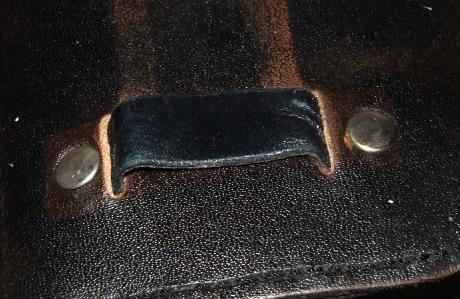-
Posts
5,928 -
Joined
Content Type
Profiles
Forums
Events
Blogs
Gallery
Everything posted by fredk
-
I have to admit, that's how it is with me right now; living room, spare bedroom, spare temporary cutting table outside, kitchen table covered in things not for eating or cooking
-

Holster patterns Ruger and Colt
fredk replied to Norwegian's topic in Gun Holsters, Rifle Slings and Knife Sheathes
Thanks A thought; could the OP make a loose fit holster for a SAA or wrap the SAA with some padding and duct tape, allow extra or tape on something for the sights, for a holster? -

Holster patterns Ruger and Colt
fredk replied to Norwegian's topic in Gun Holsters, Rifle Slings and Knife Sheathes
I have some of the Tandy patterns and they DO say which holster is for which gun Denix are limited on their guns. I have several of them including a couple of SAA and a 1860. The two the OP mentions are not made by Denix. Are any of the other guns similar? eg is a Blackhawk 7.5 anything like a SAA with 7.5 inch barrel? -
One wee thing I used to do; I cut a slot template in thickish card board. I got the slot looking good on that first, then I used a pen to trace the slot on the leather and followed the outside of the pen line as I cut the leather. I only did this when I had at least 4 slots to cut.
-
I use plumbers aluminium heat proof tape. Comes in a big roll 2'' wide. Costs about £5 to £8 per roll. I've multi-tested it and it works perfectly
-
Two extreme things to try; 1. washing it down with cellulose thinners 2. putting it in a bed of oatmeal or kitty litter, for either of those to absorb the excess oil out, but that could take weeks
-
Excellent Thanks for sharing your results
-

check out this hoodicky
fredk replied to chuck123wapati's topic in Gun Holsters, Rifle Slings and Knife Sheathes
I've finally tracked down two of the other sizes of KAM Snaps T3 = 11 mm diameter T8 = 14.1 mm diameter I think I'll order some T8. I want some bigger KAMs and I'll see if that size will cover the 15mm snap base edit; I just found another size T15 = 16 mm diameter I'm ordering those uns -
My local version is called 'Astonish'. The instructions are exactly the same as 'Mop and Glo'. I used to use the M&G as it was years ago 'Future' then 'Pledge with Future Shine'. Then it went off the market and I found 'Astonish'. Astonish and the original 'Pledge....' was water thin and clear, now they are like diluted milk, but they dry perfectly clear. I've also discovered, I think, that the US M&G is thicker than water and needs diluting down Check the instructions on that BONA stuff. Especially if it says remove with ammonia. Thats a big clue. Actually you can remove it and thin it with alcohol. I've thinned Astonish with IPA for spraying. It doesn't really need thinning for spraying but the alcohol makes it dry really fast even though it dries fast anyways Thin it down with water until its like brushing on water. I prefer to paint brush it on.
-
If you have a gloss, add some talcum powder to it to make it matt
-
Check out 'Bona High Gloss Hardwood Floor Varnish' 32 oz bottle, C$19.99 at Lowes. Check that it says on the instructions label things like 'dilute into a bucket of water' 'use a mop to apply' 'remove after 5 coats' 'remove with ammonia diluted in water' There may be something much cheaper out there. I get a local version £1 for 750ml [25 oz] We gotta find you something
-
1. a beeswax/carnauba wax mix polish 3. my old favourite - thinned 'Mop and Glo' or similar
-

check out this hoodicky
fredk replied to chuck123wapati's topic in Gun Holsters, Rifle Slings and Knife Sheathes
Right, we don't buy snap/poppers by 'Line #' but by the mm diameter of the head Here is a photo of KAM Snaps heads on the bases of two sizes of regular snaps On the left, a KAM head is wider than the base of a 12mm classed snap, but, on the right, the base of a 15mm class is about 1.5 mm wider that the KAM head Actual measurements [approx, cos my gauge ain't 100% accurate ] KAM head = 12.4mm to 12.6mm [slight variation] 12mm snap base = 10.9mm 15mm snap base = 14mm If you could be bothered you could file the larger snap base down to fit under the KAN head. It wouldn't take much filing to take off about 0.7mm all round it ~~ I now remember that I used these to cover the bases of ready rivets before I discovered double-headed rivets -
Same direction as the rest of the strap, A quick sketch; That how I do them However, sewing is by far better, and I'll stick my neck out and say, saddle stitching is the best. When I was in that medieval thingy I had plenty of sewn strap loops to repair. They'd been sewn on with a sewing machine and when the thread broke all the stitching came away. We once had a very dangerous incident when one of the guys was in the middle of a sword fight demo and the stitching on the belt loop of his dagger sheath gave way, allowing it to fall to his feet, tripping him up just as his opponent was swinging a sword at him. Fortunately the opponent was able to to pull and redirect the blow. The belt loop had been sewn on with a sewing machine. We then went through all the equipment and I re-stitched everything that had been machine sewn
-

check out this hoodicky
fredk replied to chuck123wapati's topic in Gun Holsters, Rifle Slings and Knife Sheathes
There are plastic 'snaps'. They are available in 3 sizes afaik. They are called 'KAM Snaps' T5 is the most common size. It needs a special pliers tool to set them, by squeezing and squashing the central pointy bit, which actually looks the same in your sample photograph. I use them on 'key ring coin purses' and other lightweight items. I must see if one of their heads will do the same job -
The Art of Making Leather Cases Volume 1 by Al Stohlman, pages 7 & 8 Just a small selection of my slot punches; Most useful, especially for the slot for a buckle tongue. If I need a slot longer than one of these I just move it over and hit it again. I've accumulated these over the years. Buying a few now and then. Each cost between £2 and £5 through ebay. But, they are worth their investment. [ I think I need to sharpen some of them, they've been neglected, ] A picture; one of the strap loops on my 'EDC' pouch that I made over 20 years ago Remember, that's over 20 years of irregular use. It got more use this last 2 1/2 years, carrying spare masks, rubber gloves et cetera. It was used a lot from 2000 to 2016 though I skive the edges of the strap but leave the area where the rivet will go thick. I also glue a very thin [ 0.5mm - 1oz, or less] leather over the whole back piece. In the case of my mobile [ cell ] phone holster this extra [ minimal ] thickness helps keep the phone in tightly
-
a. I have various widths/lengths of 6mm thick flat steel bar. I clamp one of these to a work bench and slip the project over it. The bar is the anvil then I set the rivet, with or without a setter bar. You are doing the rivets the same way, just the strap comes through a slot from the inside [or goes into the inside] b. According to Al, his method spreads the load on the rivet head and the leather. I have a belt pouch I made over 20 years ago. When I made it, according to the instructions, with the belt straps just riveted on the outside, the rivets were pulling out of the main pouch. About every 4 to 6 weeks. A real bummer to replace the rivets as I had lined the pouch so it had to be taken apart, rivets replaced and it all sewn up again. Then I discovered Al's method. I redid the belt straps his way and I've not had to re-do the rivets since
-
I use a local to me version of 'Mop and Glo', an acrylic varnish. Its not unlike Resolene, but I found several years ago Resolene was no longer doing the job [ change of formula maybe ? ] My sealer is thinner than the US version, mine is water thin. Just one coat seals well but I put on two coats
-
+ 1 for stitching But when I use rivets I use Al Stohlman's method; cut a slot in the project, feed the loop part into the project and rivet.
-
I bought my awl handles in a hardware shop. As file handles. 50p each.
-
Any size you want, but I'd say over 1.25 inch to under 2 inches
-
That reminded me; last time I got some awl blades they were longer than the stated length. The seller was quoting the useable length, not the overall length which included some for going into the handle. eg I bought 1.75 inch and got ones over 2.3 inch
-
A. British 'coppers' were bronze which is quite hard b. Current 'coppers' are bronze coated iron c. you need to go back to pre-2000 coins to get pure bronze 'coppers'. Anything of that age are either in collections or has been gathered in by the Royal Mint d. I drilled a small pilot hole in the handle, then heated the end of the awl blade and made it burn its way into the handle e. I prefer shorter blades too
-
As the inner piece won't really be seen, it can be a butt joint or skive each end, overlap the ends and sew. I'd certainly skive the ends of the outer piece and overlap them
- 8 replies
-
- sewing leather
- leather bracelets
-
(and 2 more)
Tagged with:
-
I would sew the ends of the inner piece together and have the ends of the outer piece at 180* from the joint of the inner piece
- 8 replies
-
- sewing leather
- leather bracelets
-
(and 2 more)
Tagged with:






